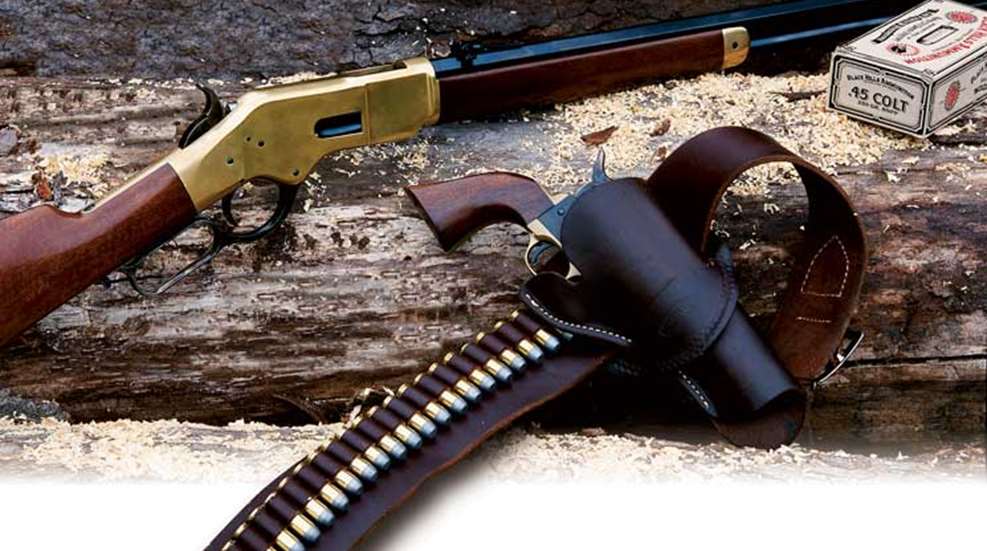
One of the more persistent practices in handgunning is the belief in the efficiency and widespread use of a handgun that shoots the same ammunition as a rifle. In history, we know that the practice began almost as soon as metallic cartridges began. Usually, this is seen as early as 1873 and the introduction the Winchester rifle of that year, as well as the .44 Winchester Center Fire cartridge, aka the .44-40. Actually, it was a few years later before Colt chambered the first Peacemaker in the new caliber. Some authorities have noted that the earlier Henry and '66 Winchester rifles fired a short .44 rimfire cartridge and a few revolvers existed that used the same ammo. I have yet to see a reference to anyone actually doing this, but it is chronologically possible. For the most part, the rifle and handgun combo as a widespread practice began with the Winchester and Colt .44-40. It was also occasionally done with the .38-40 and .32-20 cartridges.
You have to remember that all of this was happening in an America that was more than half untamed wilderness. Frontiersmen could not rely on finding a Cabela's around the next bend of the highway. A re-supply of anything might be many miles and many days away, so a single type of ammunition made a lot of sense. Understand that, in the .44-40 combo, it was first a rifle cartridge that by chance could be used in a revolver. Magazine capacity was very important in a shoulder-fired weapon with roots in the bloody battles of the Civil War. A '73 carbine with a magazine tube all the way to the muzzle gave the frontiersman a 10+1 capacity. Four more inches of rifle barrel gave him four more rounds in the tube—14+1. Effective range was maybe a hundred yards. The major advantage of a same-caliber revolver was it could be used in one hand as the other was controlling a horse. It could also be handy to have a holstered sixgun at your waist while working with both hands—the rifle was on the horse. A great deal of life depended on the horse in that period, so much so that horse stealing was a serious crime.
The major advantage of the .44-40 as a rifle cartridge was its size; it was compact and lots of them would fit in a magazine tube. It was also powerful enough to kill deer-sized creatures within its range limits. But as the movement west continued, it became obvious that a 100-yard rifle cartridge was not going to be effective because it left a lot of out-of-range meat on the hoof. Many shooters did cling to the .44-40 carbine/revolver combo well into the 20th century. But advances in firearm and ammunition technology essentially extended the range of rifles in general. Commerce grew to the point where ammo was far more readily available than in the past. The utility of the same-ammo-for-both guns concept began to lose its utility. It came of age right on the cusp of smokeless powder, when new rifles, new cartridges and new optics pushed the handgun farther away from the rifle than ever before.
The Frontier-era guns of this type left behind are some of the greatest guns in American history. Winchester developed, produced and sold hundreds of thousands of lever-action Model '73 and '92 rifles and carbines. The '92—my favorite Winchester—was Hollywood's go-to lever gun and still is. It has even been re-introduced. So has the 1873 and the 1866. It wasn't all Winchester, either. Marlin made a lot of lever guns in revolver-compatible calibers. So did other makers, like Remington with a slick little pump-gun. Revolvers? Plenty of those. Colt, Smith & Wesson, Remington and Merwin, Hulbert all made strong and efficient sixguns in the mentioned calibers.
Some of these guns continued well into the 20th century, a time when the industry developed so-called “Magnum” revolver calibers, like the .357 Mag. and .44 Mag. Guns for these rounds were designed with better materials and extended revolver performance considerably. After World War II, when the industry got cranked up and rolling, we also began to see a few carbine style rifles that fired this new class of cartridge. Brute-strong Marlin lever actions and even some semi-autos appeared, as well as Browning copies of the Winchester '92. They were handy and powerful guns, but were seldom paired with a revolver.
The 20th century—particularly the late 20th century—was a time when the semi-automatic pistol supplanted the revolver in police and military holsters nationwide. Since all modern semi-autos feed from a sheet metal box that comes out of the pistol when the cartridges are fired, it should be fairly easy to build a little carbine that takes the same magazine. It is easy and it has been done. Imagine the ease with which a beleaguered policeman could pull a carbine out of a rack in his cruiser and feed it with the magazines off his belt—the ones that work in his pistol. The guns could be 9 mm, .40 S&W, .357 SIG, .45 ACP or possibly other calibers. Marlin once made what they called a Camp Carbine. It was a light and handy little gun with conventional lines—your choice of 9 mm or .45. It used S&W 5900 series magazines in 9 mm and 1911 Colt in .45 ACP. Later on, Ruger came out with a very similar-looking carbine with magazines in common with its P-series autos. While a few agencies adopted them, it was too few and both were eventually discontinued. The basic idea of a combo, with both a pistol and carbine that are strongly appealing, has not caught on well enough to be commercially successful. These days, if police officers need carbines (and they often do), they are best outfitted with some form of AR.
There is no way you are ever going to come up with a pistol that shoots any modern rifle cartridge. As there is an active competition among the cowboy shooters using the same style guns and calibers as the westerners of history, I would expect their replica guns to prosper. And none of this should be considered an indictment of the pistol caliber carbine. Just because a target is at pistol range, doesn't mean that you have to use a pistol. The nature of a pistol caliber carbine is such that it probably gives you a better chance of getting the hits.
It is an interesting topic. I am a little amused to realize that it all started in an effort to increase magazine capacity. Nothing changed there.
Photo by Bryce Towsley




































